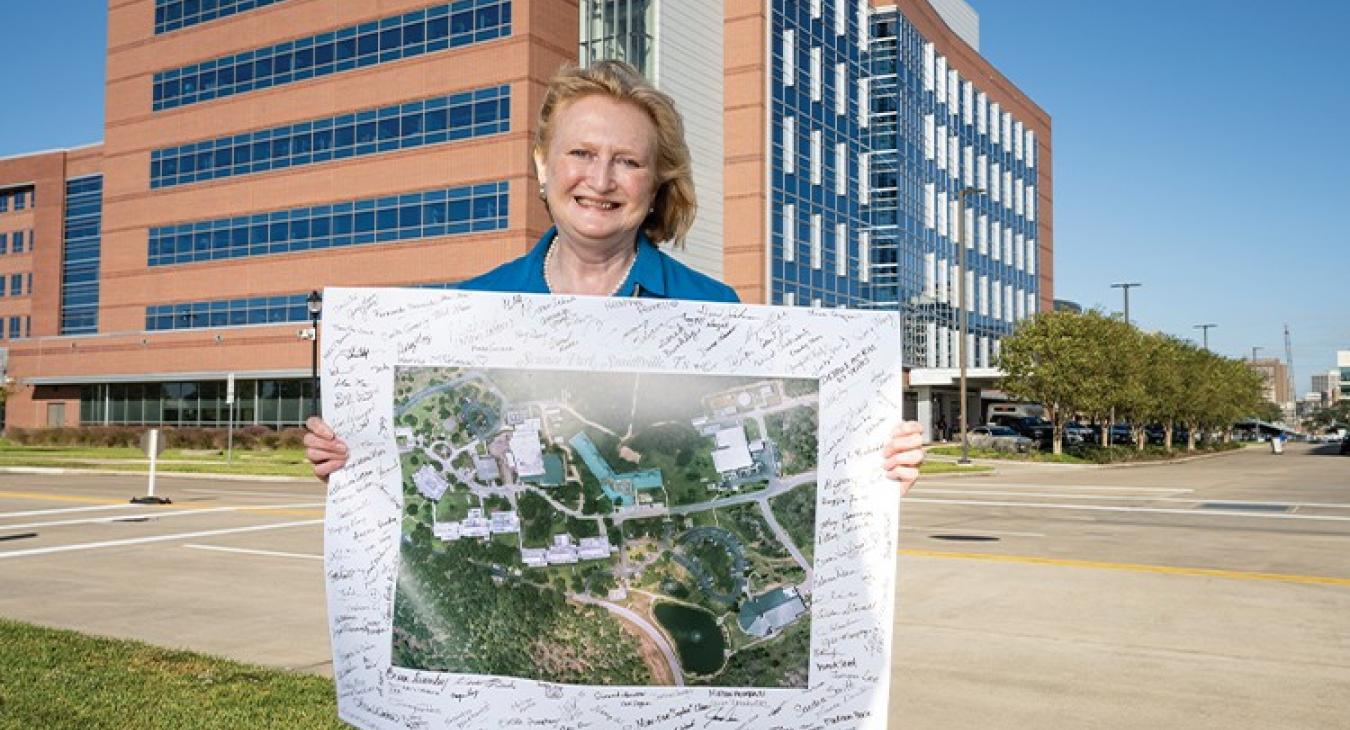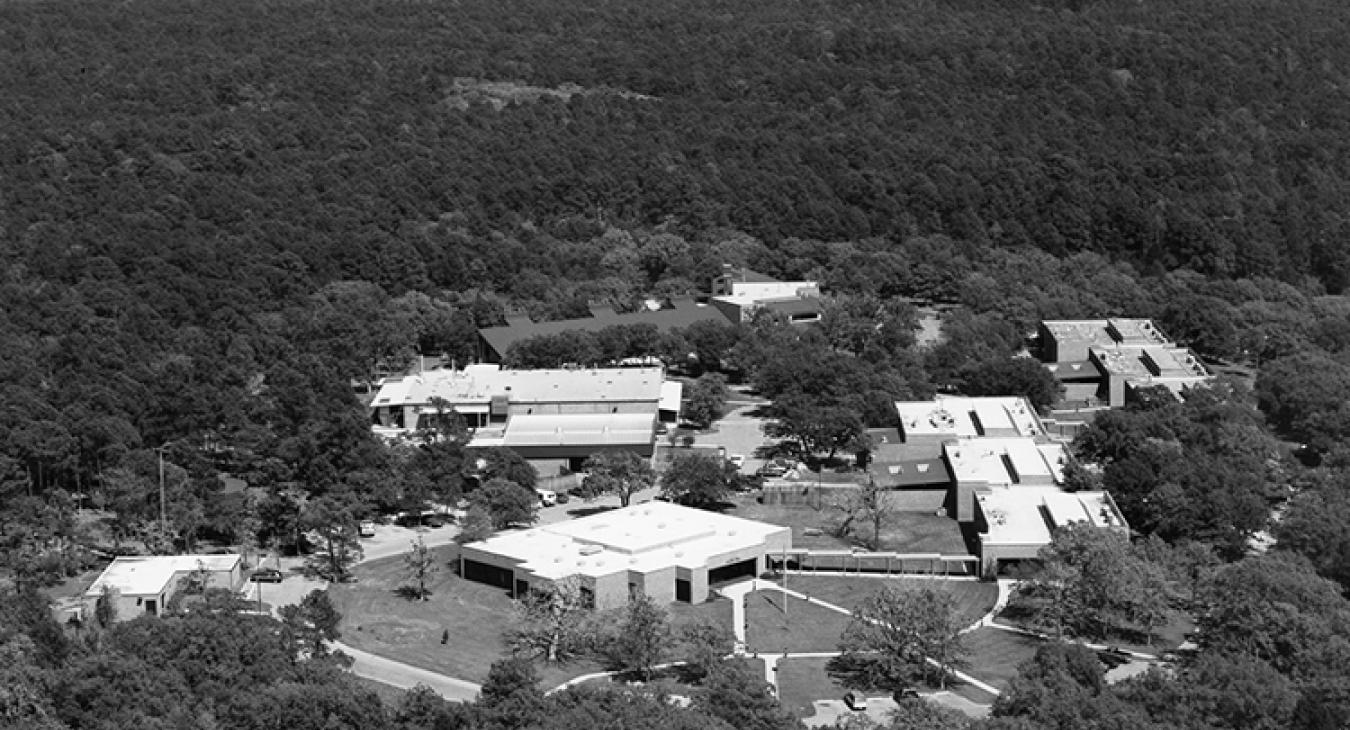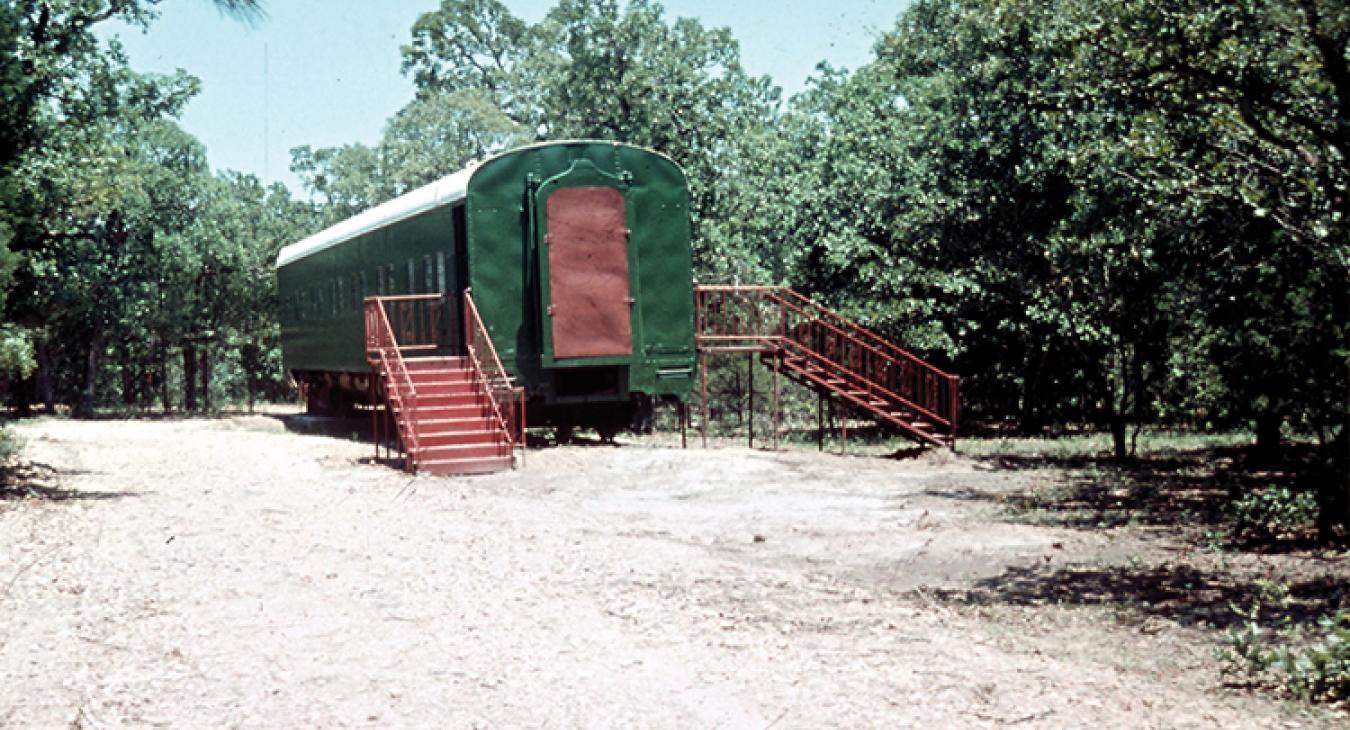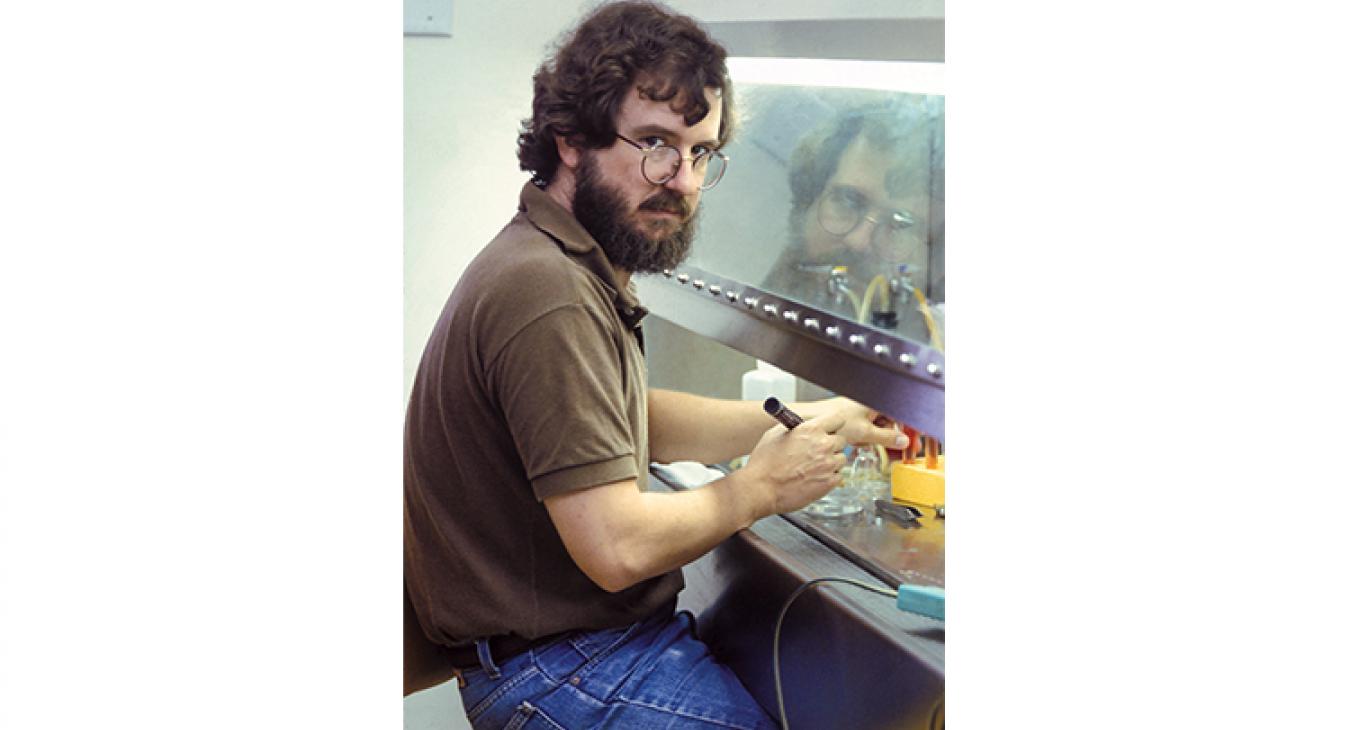Sharon Dent was among some 50 employees who gathered for an outdoor farewell to Science Park on June 29, 2021, which included a group walk on the path looping around the site. They signed an enlarged aerial campus photo that now hangs near Dent’s office at an MD Anderson research facility in Houston. (Photo by Adolfo Chavez III, The University of Texas MD Anderson Cancer Center)
Story by Sharon Jayson
Deep in the loblolly pine forest near Smithville, tucked away from public view for more than four decades, a trail of knowledge was blazed that may someday lead to a cure for cancer.
Some of the best and brightest minds in science and medicine gathered to work in a research center on 69 acres adjacent to Buescher State Park in Bastrop County. Their inconspicuous facilities left very conspicuous advances in medicine.
The roster of researchers who toiled in the Lost Pines area include the homegrown Texan who won a Nobel Prize for discovering a way to stimulate the human immune system to attack cancer cells (immunotherapy) and the Texas-educated molecular biologist whose research team proved that smoking causes lung cancer.
The idea factory in the forest was known simply as Science Park to those who worked there, as well as to the locals who were proud of their neighbor. Although few outsiders knew of this hidden gem, its research into the origins of cancer and cancer prevention made it an international star.
Now, the site that’s been part of The University of Texas MD Anderson Cancer Center is no longer in use. Work there ceased at the end of 2021. The land is for sale by the University of Texas System, but the property’s deed stipulates that the next owner must continue to use it as a research facility.
Texas lawmakers established Science Park in 1971. After that, the University of Texas System Cancer Center in Houston (now MD Anderson), acquired 717 acres of forested land that surround Science Park’s facilities.
The research center’s first laboratory was an old Pullman railroad car. Science Park opened to researchers in 1977 after additional labs and a conference center were built.
For those who worked there both recently and decades ago, the setting was idyllic, with lunchtime hikes, eating outside at picnic tables and watching deer and roadrunners.
That daily interaction with nature fostered creativity and provided the right backdrop for pioneering breakthroughs.
One of the first scientists to arrive was Jim Allison, a recipient of the 2018 Nobel Prize in Physiology or Medicine. Allison studied T cells, known as the soldiers of the immune system because they fight cancer, bacteria, viruses and other abnormal cells. His work defined the basic structure of immune cells, which led to his discovery that an individual's own immune system could attack tumor cells. He left Science Park in 1984 for the University of California, Berkeley, but returned to MD Anderson in Houston in 2012.
He has received numerous other awards and honors over the years, and today holds multiple titles, including chairman of the Department of Immunology at MD Anderson.
“I have nothing but fond memories of the great team and incredible atmosphere at Science Park,” Allison said in a written statement to Bluebonnet Electric Cooperative for this story. “After beginning my research on T cells there, then returning to MD Anderson three decades later, it was another full-circle moment to welcome researchers from Science Park to Houston this summer (of 2021) and to share some nostalgia for a very special place.”
Molecular biologist Moon-shong Tang overlapped with Allison for a few years at Science Park, having been recruited to the rural center in 1982 from his post as a research associate at Washington University in St. Louis.
“The location is just ideal,” said Tang, who spent 17 years at Science Park. “It was a really, really good environment. We were all pretty young and we became a really tight community and very good friends. We’d have dinner in Bastrop or Smithville, and after dinner, have discussions about science.”
“The people there just loved science. There was a lot of talent, and it was very novel research,” he said.
Tang left Science Park in 1999 to join New York University at the NYU Grossman School of Medicine. His work provided proof that smoking causes cancer by linking a powerful carcinogen found in cigarette smoke to mutations in a gene associated with more than half of all cancers and 70 percent of lung cancers.
“All the work that laid the foundation for my work, I did in Smithville,” Tang said. “I feel I owe them a lot. It is a quite unique place to do science and I miss it very much to this day.”
Officially the campus name was the University of Texas MD Anderson Cancer Center Science Park. In1998, the name ‘‘The Virginia Harris Cockrell Cancer Research Center’’ was added to the official name of the facility. It was shuttered because MD Anderson chose to consolidate its cancer research in Houston as part of an expansion project and because it would cost up to $100 million to repair and upgrade the center’s aging buildings.
The UT System is offering the property with approximately 150,000 square feet of buildings, laboratories and other improvements for sale. No list price has been stated.
Bastrop County officials fought unsuccessfully to keep the research center open. The 2019 announcement of Science Park’s impending closure was “a devastating blow for many people in the county,” said Adena Lewis, Bastrop County’s director of tourism and economic development.
“People had given their careers to be out there. Being a part of something that was so important to science was really great,” she said. “We felt like by supporting them, we were supporting their work.”
Though the pastoral setting of Science Park has been replaced by the urbane and massive Houston complex, the research continues.
Sharon Dent was the director of the Science Park from 2010 until its closure. She moved from the wooded campus to Houston last summer and is now the chair of, and a professor at, MD Anderson's department of epigenetics and molecular carcinogenesis.
Science Park was designed “to understand how the environment influences cancer development and cancer risk,” with a focus on DNA repair, she said.
“Back in the 1970s, it wasn’t really understood how a lot of those things like chemicals or sunlight influence whether a person got cancer,” she said. “A big part of that is understanding how cells and organisms normally work and how they defend themselves against such dangers. They damage our genetic blueprint.”
“Some (Science Park) research was aimed at determining which chemicals cause cancer,” she said. “Some was more biochemical in identifying molecules that can repair DNA damage. Other research actually identified what kind of UV light in sunlight gives rise to tumors.”
Dent says the research portfolio now is much broader, including her own interest in defining how our genome is “folded.”
“If we took DNA out of our cells, you might be surprised to know it would stretch out to more than two meters in length,” she said. “That two meters has to be folded so much that it can fit into a microscopic nucleus inside the cell. You’ve got a very complicated blueprint,” she added, likening it to the multi-page, often mind-boggling instructions for assembling furniture from IKEA.
“Imagine what happens if you start reading the wrong part of the instruction at the wrong time. Cancer is reading the wrong part of the blueprint so that the cell is no longer behaving the way it should. It’s building the wrong structures and changing its identity and reacting to the environment differently. My group is trying to understand what controls that folding to make sure we’re reading the right instructions at the right time.”
Being next to Buescher State Park was “a very idyllic situation” for researchers, she said. “Being in a park with deer and roadrunners and baby foxes running by, we were immersed in the nature of the place.” However, she said the isolation could “make it little bit difficult to recruit new students and new postdocs.”
Among the recruits Dent found in New York City was Kevin McBride, an MD Anderson associate professor who spent 10 years at Science Park before it closed. McBride had been at The Rockefeller University, a premier biomedical research university in Manhattan, where he lived with his wife and two young children in what he described as a “high-rise shoebox.”
“Most biomedical research universities are in urban environments,” said McBride, who lived in Bastrop and is now at MD Anderson in Houston. Smithville and the Science Park provided “a unique setting that gave it a unique culture. It felt like a very supportive community. It was close-knit. You knew everyone on the campus personally, from the guards to the people who worked in the facilities, and you knew what each other was working on. Because of that, they were very invested in the mission.”
Detailed information about the founding of Science Park can be found in a 2009 book, The Science Park: Dream to Reality, The First 20 Years, by Earl F. Walborg, Jr., a biochemist who worked at the bucolic research center. He detailed how state and national political leaders, as well as UT officials and local community leaders joined forces to create the research park. His book also credits Smithville residents for their fierce lobbying to get Science Park.
The people of Smithville were unhappy about preferences toward development and promotion of Bastrop State Park over nearby Buescher State Park, just outside their city.
“The sense of ownership that the citizens of Smithville felt for Buescher State Park played a major role in the proposal to site a UT Research Park at that location,” Walborg wrote. “During the early settlement of Smithville a number of its residents owned land in the nearby Lost Pines Forest as a source of timber and firewood. Since the land was worthless for grazing livestock or cultivation, privately owned tracts were largely unfenced. During the Great Depression, two tracts of land were transferred to the State of Texas to found Buescher State Park.
“In 1933 a prominent Smithville family, the Bueschers . . . deeded 318 acres to the State; and in 1936 the City of Smithville added a contiguous 1,412-acre tract it had purchased from various families. Thus, the State of Texas was indebted to the Smithville community for the very existence of Buescher State Park; and this fact empowered the Smithville community as it lobbied the State to develop the Park in a manner that would enhance the local economy.”
Of the 193 people working at Science Park when its relocation to Houston was announced in 2019, 123 remained on the payroll by August 2021, either moving to Houston or accepting positions elsewhere within MD Anderson. The remaining 70 either retired, found new employers, completed postdoctoral training, had jobs that didn’t transfer or were realigned, according to a statement from Yolan Campbell, MD Anderson associate vice president.
In addition, 1,500 pieces of research equipment moved to Houston. “Items at the end of their lifespan did not move and may be negotiated as part of the property sale,” Karen Mooney, MD Anderson associate vice president, said in a statement. “Any remaining decommissioned state property not transferred to the future owner will be sold at auction.”
For years (except in 2020 due to COVID-19), Science Park offered programs for area high school students as well as university undergraduates from across the country. David Johnson was involved with the summer programs since he arrived at Science Park in 1994. He directed the program for the past decade, including in 2021, when only university students participated. Johnson, who lives in Bastrop, was one of the two Science Park employees who retired rather than move.
“It had this atmosphere where you could really focus on science and really clear your head,” he said.
The communities that considered the research park a good neighbor now hope for another exceptional experience when the next occupant moves in.
“To have a major cancer research facility in Smithville was a point of pride for the community,” said Smithville Mayor Joanna Morgan. “We’d like to feel comfortable that the sale is being pursued aggressively to get it occupied as soon as possible.”
In the meantime, the wildlife that populates Buescher State Park and its neighbor Science Park are the sole inhabitants, waiting in the dappled shade of pines and post oaks to inspire the next researchers seeking answers to some of humanity’s most vexing problems.












